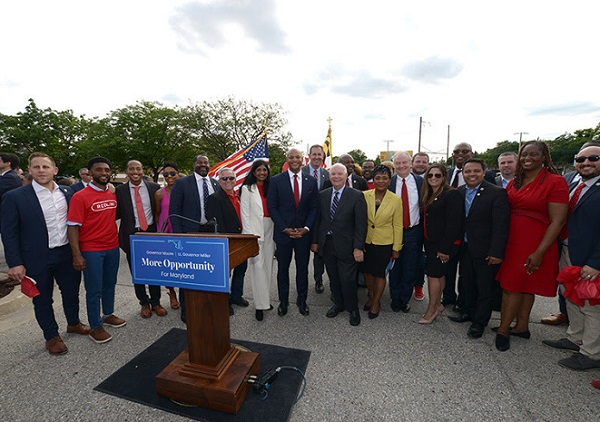ANNAPOLIS, MD—Flanked by local, state, federal and community leaders, Governor Wes Moore on Thursday announced the relaunch of Baltimore’s Red Line, a major investment in transit to enhance east-west connectivity across the Baltimore region.
Governor Moore made the announcement at the West Baltimore MARC Station joined by Lieutenant Governor Aruna Miller; Maryland Department of Transportation Secretary Paul J. Wiedefeld and Maryland transportation officials; elected representatives from Maryland’s congressional delegation, the Maryland General Assembly, Baltimore City, Baltimore County; as well as agency partners, community advocates, and transit stakeholders representing a wide range of businesses and organizations.
“Nearly a decade ago, the previous administration cut the Red Line project at a time when Baltimore was reeling from one of the most trying eras in recent history – but now is the time for us to get this right,” said Gov. Moore. “We’re going to work together and seize this moment in our nation’s history when the stars are aligned to invest in public transit. Our communities are expanding, our jobs are growing, and we need to make sure that everyone in the region can get from where they live to where opportunity lies.”
“As a transportation engineer by trade, I know the extraordinary value transit options bring to communities,” said Lt. Gov. Aruna Miller. “Transit options create pathways for people to go from where they live to where the opportunities are, but for a huge swath of Baltimoreans, those pathways and those opportunities have been limited. The Moore-Miller administration is changing that by kickstarting the Red Line – a project that will transform Baltimore City into a model for what a fully-integrated transit network looks like.”
Beginning two decades ago, the Baltimore Red Line proposal sought to improve transit efficiency, fill an east-west transit gap, increase access to work and activity centers, provide connections to existing transit and other transportation modes, offer more commuter choices, and support economic development and community revitalization.
“Before it was canceled in 2015, the initial Red Line plan was shaped by more than 10 years of study, engineering, environmental analysis, and substantial community participation,” said MDOT Secretary Wiedefeld. “Having signed the original Red Line Community Compact fifteen years ago, I know this project and the tremendous benefits it will bring to the community are long overdue.”
Insights and commitments from technical work and community engagement conducted for the original plan, together with the Central Maryland Regional Transit Plan East-West Corridor Feasibility Study completed in 2022, provide a strong foundation for the project’s relaunch.
In the coming months, the Maryland Transit Administration will lead the next development phase, building on community participation to update and modernize the Red Line plan to meet the region’s needs and aspirations. Key considerations include:
- Transit mode: Both light rail transit and bus rapid transit options were evaluated in the prior Red Line Environmental Impact Survey and in the East-West Feasibility Study.
- Tunneling: Options to reduce or eliminate tunneling downtown through on-street alignments to assess cost, benefits and drawbacks to tunneling.
- Highlandtown/Bayview alignment: Due to recent development in the Highlandtown area.
- Environmental changes: Assessment to reflect any conditions that have changes since 2013 and integration with other projects
The Maryland Transit Administration will request entry into the federal Capital Investment Grants program in 2024, which requires Federal Transit Administration oversight and would make significant federal financial assistance available to advance the project to full implementation.
The Maryland Transit Administration will also launch the Eastern Baltimore County Access Study to evaluate alignments for further expansions east into Baltimore County. This future phase of the Red Line will seek to connect the current alignment to the job centers in eastern Baltimore County.
As Maryland begins to fulfill long-delayed promises to the Red Line corridor communities, the transit administration will act to implement solutions to improve east-west bus service now, including the August 27 launch of the QuickLink 40 service. This limited bus service pilot will operate between the Essex Park-and-Ride and the North Bend Loop to help improve travel times with reduced transfers between the CityLink Blue and Orange buses.
The Maryland Transit Administration is also making investments through its Fast Forward program to make bus shelter improvements, provide real-time information signs, and make Americans with Disabilities Act improvements. Federal investment will also help address transit priority treatments, including bus lanes and pedestrian safety.
The administration values community input and will undertake an intensive community engagement effort to gather, share and consider project options. The first public engagement period is expected to begin in mid-July and continue through mid-August 2023.
To learn more about the Red Line relaunch, visit https://www.redlinemaryland.com, sign up to receive project updates through email at [email protected], and follow the Red Line relaunch on social media @redlinemaryland on Facebook, Twitter, Instagram and YouTube.
“Reviving Baltimore’s Red Line project is part of a larger push for federal investment in Baltimore City and its economic future. With several other major, federally-funded infrastructure projects underway or in planning in and around the city, our sights are set on better, more extensive transit infrastructure to connect neighborhoods, attract new business, and create local jobs,” said Senator Ben Cardin (D-MD). “Advancing the Red Line is critical for better east-west connectivity, regional economic growth, and the opportunity for Baltimore City to realize its full potential.”
“Today’s relaunch of the Baltimore Red Line plan is a key step towards renewing our commitment to deliver much-needed public transit between East and West Baltimore. Senator Cardin and I included a provision in the infrastructure modernization law to ensure this vital project won’t have to go to the back of the line for federal funding and we stand ready to work with Governor Moore and the Baltimore community to revive this vital transportation initiative and provide a big economic boost to Baltimore,” said Senator Chris Van Hollen (D-MD).
“Through transparent and effective community participation and engagement, this project could bridge a transportation gap, similar to the Highway to Nowhere, that has lasted for far too long,” said Congressman Kweisi Mfume (D-MD).
“For years, we have been saying that the Red Line is central to strengthening Maryland’s economy and ensuring its people can access the infrastructure they need to, in turn, access opportunity. Nothing about that has changed,” said Congressman Dutch Ruppersberger. “In fact, our commitment to this project has only strengthened and I look forward to doing whatever I can to secure the federal resources necessary to make it a reality for my constituents.”
“The value and positive impact this relaunch of the Red Line will bring to Baltimore City and the entire region is impossible to overstate,” said Mayor Brandon M. Scott. “The original loss of the Red Line was a catastrophic and intentional disinvestment in our great city. Now, with the Moore Administration, Baltimore finally has a partner in Annapolis who is committed to reviving the Red Line and making transit in this region a top priority. I am incredibly excited to work with all of our partners at the federal, state, and local level to finally get this economic driver for Baltimore’s future kick started once again.”
“I am grateful to Governor Moore for breathing new life into this long-awaited and desperately needed transit project that will better connect all our residents with everything the Baltimore region has to offer,” said Baltimore County Executive Johnny Olszewski. “A transportation project of this scale must be holistic and reflect how our region has grown and changed, and I appreciate the Governor’s support for having the next phase of the Red Line further connect with the transformative job opportunities available at Tradepoint Atlantic and across Eastern Baltimore County. We look forward to collaborating with our federal and state partners to support a truly interconnected project that will serve our entire region for generations to come.”
Photo via Baltimore County Government


